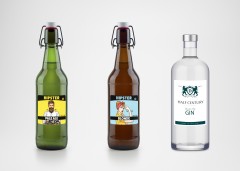Standard self-adhesive materials tested with UV inks: Printing perfect labels right from the start
Digital printing continues to gain ground, which means that digitally printed labels on rolls are being used more and more due to their cost advantages in small batches. Dantex, a company with its headquarters in England, who originally specialised in providing water wash photopolymer plates and related processing devices, have already identified this trend, and have presented their first digital UV inkjet label press at the 2015 Labelexpo. At the company’s German subsidiary in Bensheim, label printers can now experience the PicoColour and its possibilities for the first time in a specially designed showroom. Extensive tests with standard self-adhesive materials from HERMA have now confirmed an excellent printing quality and outstanding profitability. “Our products HERMA PP white extra tc (grade 880), HERMA PP 50 transparent tc (grade 885), and HERMA PP silver tc (grade 891) can immediately absorb UV inkjet ink – the print image is excellent thanks to optimal ink adhesion”, comments Timo Kerilahti, who works for the technical service in HERMA’s Self-adhesive Materials Division. “This opens up a whole range of new options for label printers. Especially in the production of very small batches, they can now optimally meet the market’s challenges with a wide range of materials and great versatility”, says Peter Schlösser, responsible for equipment technology at Dantex Germany. “We have been successfully cooperating with HERMA UK for many years and can attest to the long-term high quality of the material for our purposes.” Two further HERMA paper products were tested on the PicoColour: HERMAextracoat (grade 242) and the self-adhesive material for wine bottles, HERMAfelt white brut (grade 316). These products also proved ideally suited for the digital UV inkjet label press. In the case of HERMAfelt white brut, the PicoColour showed that it can print on textured and thus very demanding paper with very good results.
Productive, versatile, and robust
With a printing width of 210 mm, the PicoColour system can process a wide variety of substrates. It tackles materials with a maximum thickness of 100 – 300 microns and a maximum web speed of 25m/min. The system works with UV based ink and can be upgraded to a five-colour configuration to achieve an opaque white. Since plate-making and make-ready are no longer required, perfect labels can be produced right from the start, making PicoColour a very profitable system. On top of that, the machine is easy to operate and features a very robust design. “Combined with HERMA self-adhesive materials, our UV inks are light-resistant, scratch- and abrasion-proof and also resistant to heat, chemicals, and water. Therefore, they are particularly suited for self-adhesive labels in the beverage, health, cosmetics, industrial chemicals, household chemicals, and industry sectors”, comments Peter Harms, sales manager and authorized signatory at Dantex. The PicoColour’s “big brother” PicoJet will bring about even more possibilities and extended versatility in the future – its commercial launch is currently being prepared.






